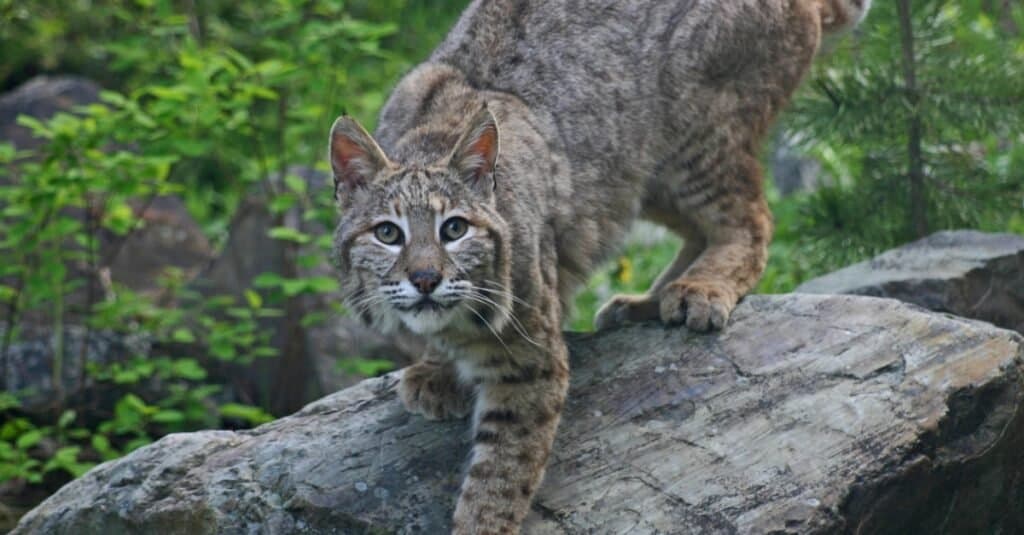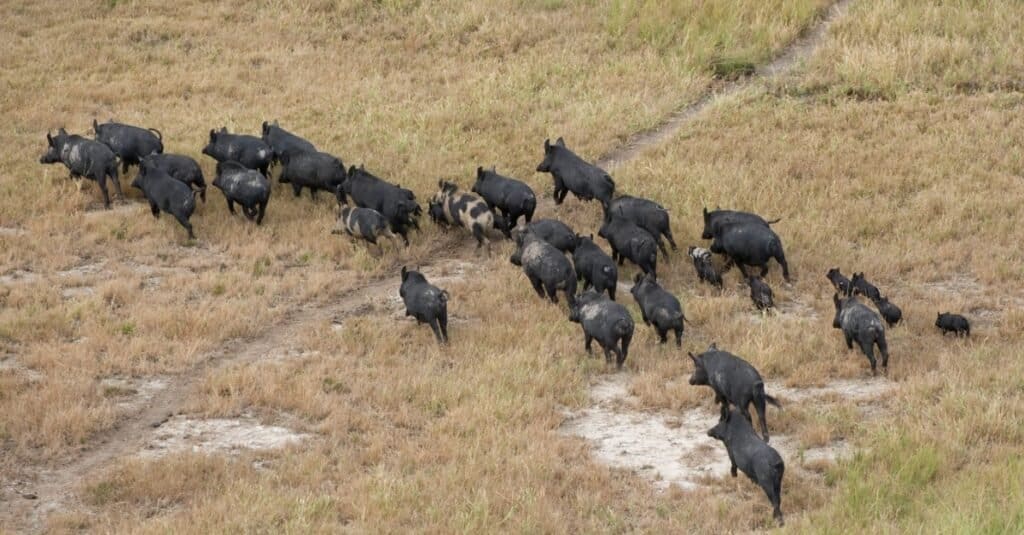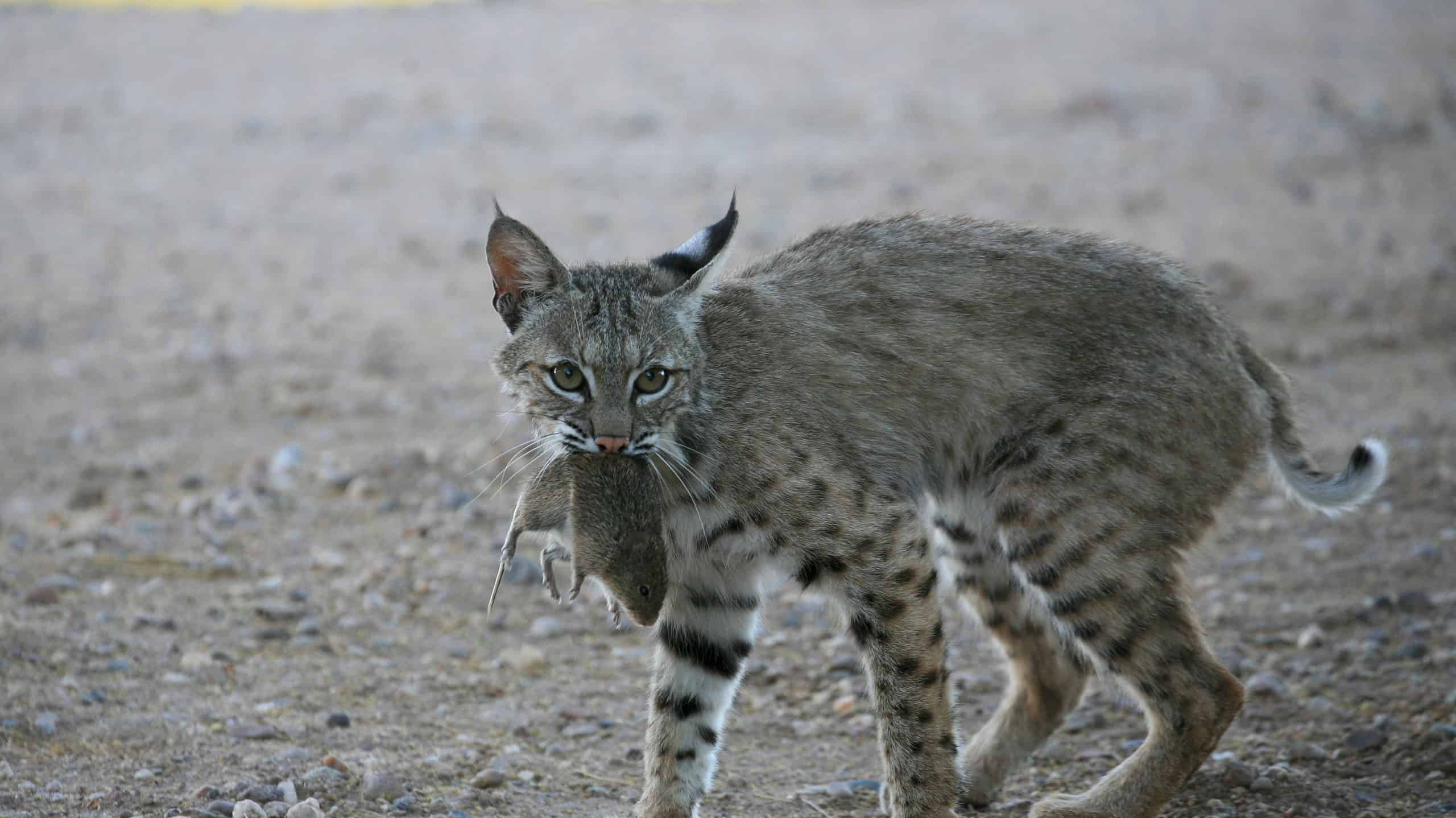Bobcats and feral hogs are common throughout Texas — the former are abundant in South Texas, while the latter is reportedly plaguing the entire state. As a result, it goes without saying that the two species will eventually meet in the wild.
Moreover, given that the bobcat is an adaptable predator and the feral hog is an aggressive animal that will not enjoy the intrusion of the former, it’s clear that a bobcat vs. feral hog battle has a high possibility of happening!
Naturally, you’re probably wondering who will win between the two: will it be the native North American cat or the aggressive feral hog?
What Is a Bobcat?

The bobcat (or red lynx) is a cat species native to North America.
©iStock.com/Anita Elder Design
Scientifically known as Lynx rufus, the bobcat or red lynx is a cat species native to North America. It is known for its large population and wide distribution, being found in Mexico, throughout the United States, and southern Canada.
The bobcat can be easily identified with the help of its forelegs, which feature black bars. One can pay attention to the animal’s tail as well — it has a black tip, and it’s quite bobbed. Without the tail, bobcats can grow up to about 50 inches (125 cm) long.
As mentioned, this cat species is often referred to as an “adaptable predator,” mainly because it can be found hunting in various environments: forest edges, wooded areas, swamplands, urban edges, and semi-deserts, to name a few.
The bobcat’s diet changes depending on the surrounding environment. Its favorite meals are hares, rabbits, geese, chickens, birds, deer, small rodents, and insects.
What Makes a Bobcat Dangerous?
The bobcat is an agile hunter known for stalking and ambushing prey when the right time comes. A sudden pounce or a short chase is common before the final attack. According to statistics and studies, bobcats prefer mammals that weigh about 1.5-12.5 lbs (0.7-6 kg).
Besides various hunting tactics adapted depending on the prey’s size, the bobcat also makes impeccable use of its sharp and retractable claws. When it hunts large animals, this wild cat will find a covered place and use it to stalk its prey. When the target is within a 20-35 feet (6-11 m) range, the bobcat leaves its cover and attacks the prey, pouncing or chasing it.
A bobcat’s bite can generate about 548 Newtons of force, which is more than foxes, dogs, coyotes, snow leopards, and even cheetahs. Given the cheetah is an apex predator, it goes without saying that the bobcat, even though it’s a small animal standing at 12-24 inches (30-60 cm) at the shoulders, is still strong enough to strike down a feral hog.
What Is a Feral Hog?

A feral hog is a domestic pig that has escaped its enclosure or has been released by its owner and now lives in the wild.
©iStock.com/JMrocek
A feral hog is a domestic pig that has escaped its enclosure or has been released by its owner and now lives in the wild. Feral hogs or pigs are not wild pigs, while the latter cannot be called feral. According to scientists, a pig/hog can become feral only when previously domesticated (this doesn’t apply in some cases, however).
In Texas, one can come across three types of formerly domestic hogs: feral hogs, Eurasian hogs, and hybrids of the two. In 2011, millions of pigs, especially feral hogs, could be found throughout Texas. They were considered as plaguing the land, affecting crops and fields alike.
Where present, feral hogs are known to compete with other species for resources. For example, the American black bear is a direct competitor of the feral hog in conquering forest tree fruits. The downside for the black bear is that feral hogs have a significantly higher reproductive rate and can literally swarm an area clean of resources.
What Makes a Feral Hog Dangerous?
Feral hogs are considered dangerous due to their highly aggressive nature and the fact that they carry diseases they can pass on to humans and other animals including pets, such as hepatitis E, influenza, salmonella, and many more.
For other animals and potential predators, size is an aspect that makes feral hogs dangerous. An adult specimen can grow up to 3 feet tall (0.9 m) and 5 feet long (1.5 m); on top of that, it can also grow as heavy as 75 – 250 lbs (34 – 113.4 kg). Some specimens grow twice the mentioned weight, nearing 500 lbs (about 230 kg).
Who Emerges Victorious in a Bobcat vs. Feral Hog Battle?
An adult feral hog would emerge victorious in a bobcat vs. feral hog fight.
Bobcats share habitats with feral hogs more than they would like. Given its predatory instincts, you’d think the bobcat would always try to prey on feral hogs. However, this rarely happens; if it does, it will happen only with piglets and small specimens. According to statistics, bobcats’ diets consist mainly of other types of smaller animals, and feral hogs never represent a major component.
Contrary to expectations, a healthy, adult feral hog is unlikely to be taken down and defeated by a bobcat. Despite its sharp claws and powerful bite, the wild cat is simply not large enough to take a muscular feral hog three times its weight and often two times its size down.
A bobcat can feast only on piglets and injured or weakened feral hogs.
Who Is the Main Predator of Feral Hogs?

Feral hogs are predated mainly by humans.
©iStock.com/JohnCarnemolla
Due to their highly aggressive and invasive nature, feral hogs are predated mainly by humans. On the other hand, feral hogs are a big part of the Florida panther’s and the mountain lion‘s (mainly in North America) diets.
Nevertheless, given the damage they can cause to crops and farms, people are almost always likely to try and get rid of feral hogs, especially in areas infested by these animals. For example, Texan hunters can kill wild and feral hogs throughout the year without any limits or restrictions.
U.S. States With the Most Feral Hogs
While Texas is the U.S. state with the most feral hogs at more than 1.5 million, there are more than 6 million feral hogs roaming the country across 35 states.
Oklahoma also has a huge population of feral hogs, with more than 1.5 million living in approximately 70 of the state’s 77 counties, particularly in the southern regions.
Louisiana has the third-largest number of feral hogs in the U.S. It has around 700,000 feral hogs, and the economic losses they create come to about $91.1 million a year.
Find out which states are #4-#10 on our list of the 10 states with the worst feral hogs here.
Thank you for reading! Have some feedback for us? Contact the AZ Animals editorial team.








